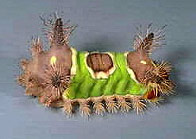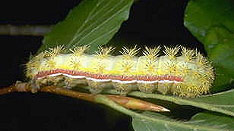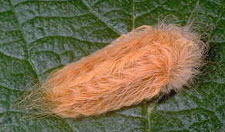This news item expired on Monday, November 30, 2009 so the information below could be outdated or incorrect.
 In late summer and fall the occasional unfortunate gardener has an encounter with one of the stinging caterpillars. There are several species of moths in North Carolina whose caterpillars are covered with stinging hairs. Fortunately reports of allergic reactions are quite rare—but the stinging sensation is never-the-less uncomfortable. Often the offending caterpillar is hiding up under a leaf that it is feeding on and the gardener does not even see it—at least until he notices the pain in his hand. These caterpillars may feed on a variety of plants, from trees, to shrubs, to hanging basket plants.
In late summer and fall the occasional unfortunate gardener has an encounter with one of the stinging caterpillars. There are several species of moths in North Carolina whose caterpillars are covered with stinging hairs. Fortunately reports of allergic reactions are quite rare—but the stinging sensation is never-the-less uncomfortable. Often the offending caterpillar is hiding up under a leaf that it is feeding on and the gardener does not even see it—at least until he notices the pain in his hand. These caterpillars may feed on a variety of plants, from trees, to shrubs, to hanging basket plants.
 The saddleback is one of the more distinctive and most common of the stinging caterpillars. Its short, stout body is brown on each end with a green saddle blanket and a brown spot in the center. This caterpillar grows to about an inch long when fully grown.
The saddleback is one of the more distinctive and most common of the stinging caterpillars. Its short, stout body is brown on each end with a green saddle blanket and a brown spot in the center. This caterpillar grows to about an inch long when fully grown.
The lo moth larva is pea-green and has greenish spines tipped with black. A reddish stripe edged with white extends down the entire length of the body. The lo moth caterpillar is about 2 inches long when fully grown.
 The puss caterpillar is roughly pear-shaped and densely covered with urticating hairs (producing wheals or itching or inducing hives), which means that they can irate the skin. The hairs may be pale yellow, gray, reddish-brown or light brown. This larva is about an inch long when fully grown.
The puss caterpillar is roughly pear-shaped and densely covered with urticating hairs (producing wheals or itching or inducing hives), which means that they can irate the skin. The hairs may be pale yellow, gray, reddish-brown or light brown. This larva is about an inch long when fully grown.
For more information, call Buncombe County Cooperative Extension at 255-5522.